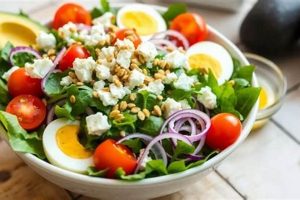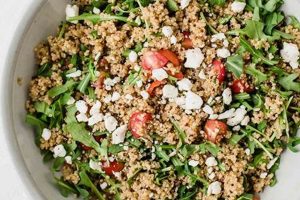Consuming nutrient-rich, low-calorie meals is a cornerstone of effective weight management. Salads, when prepared with fresh, whole ingredients and mindful portion control, offer a versatile and satisfying way to achieve this goal. A collection of diverse salad recipes provides individuals with options to suit varying tastes and dietary needs while promoting satiety and reducing overall caloric intake. Such recipes typically emphasize lean proteins, healthy fats, and a variety of vegetables to deliver optimal nutritional value.
The benefits of incorporating salads into a weight-loss plan are numerous. They are typically low in energy density, meaning they provide a high volume of food for relatively few calories, which can help manage hunger. Salads also offer a convenient way to increase vegetable consumption, contributing to increased fiber intake and improved digestion. Furthermore, the flexibility of salads allows for customization based on individual preferences and seasonal availability, promoting long-term adherence to healthy eating habits. Historically, salads have evolved from simple preparations of raw vegetables to more complex combinations incorporating diverse ingredients and flavorful dressings.
The following sections will delve into specific examples of salads ideal for weight loss, highlighting their nutritional profiles and providing detailed preparation instructions.
Tips for Creating Weight-Loss Salads
Creating salads that effectively support weight loss requires careful consideration of ingredients and portion sizes. These tips offer guidance on building nutritious and satisfying salads conducive to healthy weight management.
Tip 1: Prioritize Lean Protein: Incorporating lean protein sources, such as grilled chicken breast, fish, tofu, or legumes, promotes satiety and helps preserve muscle mass during weight loss.
Tip 2: Emphasize Non-Starchy Vegetables: Leafy greens, cucumbers, bell peppers, and broccoli are low in calories and rich in vitamins and minerals. These should form the base of weight-loss salads.
Tip 3: Choose Healthy Fats Strategically: Incorporating sources of healthy fats, such as avocados, nuts, and seeds, enhances flavor and provides essential nutrients. However, portion control is crucial due to their caloric density.
Tip 4: Limit Refined Grains and Sugary Dressings: Croutons, pasta, and sugary dressings can significantly increase the caloric content of a salad. Opt for whole grains in moderation and utilize light vinaigrettes or dressings made with healthy oils and vinegar.
Tip 5: Control Portions: Even healthy ingredients can contribute to weight gain if consumed in excessive quantities. Be mindful of serving sizes, especially for calorie-dense additions.
Tip 6: Prepare Ingredients Freshly: Using fresh, seasonal produce maximizes flavor and nutritional value. Pre-cut or pre-packaged salads may contain added preservatives or sugars.
Tip 7: Vary Ingredients for Nutritional Balance: Rotating a variety of vegetables, proteins, and healthy fats ensures a diverse intake of essential nutrients and prevents dietary monotony.
By following these guidelines, individuals can create delicious and satisfying salads that contribute to successful weight management and overall health improvement.
These practical tips facilitate the incorporation of healthy and flavorful salads into a balanced dietary approach for sustainable weight loss.
1. Portion Control
Portion control plays a crucial role in the effectiveness of salad-based weight loss strategies. While salads often consist of nutrient-rich, low-calorie ingredients, consuming excessive quantities can still hinder weight loss efforts. Calorie intake, even from healthy foods, must be managed to achieve a caloric deficit, a fundamental requirement for weight reduction. Understanding portion sizes for various salad componentsleafy greens, vegetables, proteins, fats, and dressingsis essential for creating balanced meals that support weight loss goals. For example, a large salad overflowing with high-calorie toppings like cheese, nuts, or dried fruit, even with a healthy base of vegetables, can quickly exceed recommended calorie limits.
Practical application of portion control in salad preparation involves measuring ingredients and using appropriate serving dishes. Pre-portioning ingredients into individual containers can facilitate mindful eating throughout the week. Visual cues can also be helpful; for instance, using a smaller plate can make a reasonable portion appear more substantial, promoting satisfaction without overconsumption. Awareness of appropriate serving sizes for various salad components, such as a palm-sized portion of protein or a thumb-sized portion of healthy fats, can guide individuals in creating balanced and calorie-conscious meals. Furthermore, mindful eating practices, such as paying attention to hunger and fullness cues, can complement portion control strategies and contribute to long-term weight management success.
Effective weight management requires a holistic approach, encompassing both food choices and portion sizes. Mindful portion control maximizes the benefits of consuming healthy salads, ensuring they contribute to, rather than hinder, weight loss objectives. Integrating these practices with regular exercise and other healthy lifestyle choices further enhances the effectiveness of a weight-loss plan.
2. Nutrient Density
Nutrient density plays a vital role in the efficacy of salads for weight loss. A nutrient-dense salad provides a high concentration of vitamins, minerals, and other essential nutrients relative to its caloric content. This characteristic is crucial for weight management as it allows individuals to consume satisfying portions while minimizing caloric intake. Foods with high nutrient density promote satiety, reduce cravings for less nutritious options, and support overall health during weight loss. A salad rich in leafy greens, colorful vegetables, lean protein, and a small portion of healthy fats exemplifies a nutrient-dense meal that can contribute to weight loss goals. Conversely, a salad primarily composed of iceberg lettuce and croutons, while low in calories, lacks the micronutrient richness necessary for optimal health and sustained weight management.
The importance of nutrient density in weight-loss salads stems from its impact on both physiological and psychological well-being. Adequate intake of essential nutrients supports metabolic function, energy levels, and overall health, which are crucial for maintaining motivation and adherence to a weight-loss plan. Furthermore, nutrient-rich foods tend to be more filling and satisfying than calorie-dense, nutrient-poor options, reducing the likelihood of overeating and promoting feelings of fullness. For example, a salad containing spinach, kale, bell peppers, and grilled chicken provides a wider range of nutrients and greater satiety compared to a salad consisting solely of iceberg lettuce and a low-fat dressing. The inclusion of nutrient-dense foods in salads not only facilitates weight loss but also contributes to long-term health and well-being.
Incorporating nutrient-dense ingredients into salads requires careful selection and preparation. Prioritizing a variety of colorful vegetables, lean protein sources, and healthy fats maximizes nutrient intake while minimizing caloric load. Minimizing processed ingredients, sugary dressings, and refined grains further enhances the nutritional value of the salad. Understanding the nutrient profiles of different ingredients allows for informed choices that support individual dietary needs and preferences while promoting effective weight management. Ultimately, prioritizing nutrient density in salad preparation ensures that each meal contributes not only to weight loss but also to overall health and vitality.
3. Ingredient Variety
Ingredient variety is a critical component of successful weight-loss salad strategies. Dietary monotony can lead to decreased adherence to healthy eating plans. A diverse range of ingredients in salads not only enhances flavor and enjoyment but also ensures a broader spectrum of essential nutrients. This variety contributes to satiety, reduces cravings, and supports overall well-being during weight loss.
- Micronutrient Intake
Varying salad ingredients maximizes the intake of essential vitamins and minerals. Different vegetables, fruits, and protein sources offer unique micronutrient profiles. For example, a salad combining spinach (rich in iron and vitamin K), bell peppers (vitamin C), and chickpeas (fiber and folate) provides a wider range of nutrients compared to a salad solely comprised of lettuce and tomatoes. This diverse intake supports overall health and metabolic function, crucial for effective weight management.
- Flavor and Palatability
A diverse ingredient profile enhances the sensory experience of consuming salads. Combining textures, colors, and flavors makes meals more enjoyable, reducing reliance on high-calorie dressings or toppings for satisfaction. This can involve incorporating ingredients like roasted vegetables, fresh herbs, or a variety of nuts and seeds. The increased enjoyment encourages consistent consumption of healthy salads, contributing to long-term weight management success.
- Satiety and Appetite Control
Different ingredients contribute to satiety through various mechanisms. Fiber-rich vegetables promote fullness, while protein sources help regulate appetite hormones. Incorporating a combination of these elements in a salad enhances satiety, reducing the likelihood of overeating and supporting weight loss efforts. A salad combining grilled chicken, black beans, mixed greens, and various vegetables offers a more satisfying meal compared to a simple lettuce and tomato salad.
- Gut Health
A diverse range of plant-based foods in salads, such as different types of leafy greens, vegetables, and fruits, promotes a healthy gut microbiome. A thriving gut microbiome contributes to overall health, including improved digestion and nutrient absorption, which can indirectly support weight management. Variety in salad ingredients helps maintain a balanced and diverse gut microbiota.
By incorporating a wide array of ingredients, individuals can create flavorful, nutrient-rich salads that support weight loss goals while promoting overall health and well-being. This approach addresses both the nutritional and psychological aspects of weight management, leading to sustainable and enjoyable dietary changes.
4. Lean Protein Sources
Lean protein sources are fundamental to the efficacy of salads designed for weight loss. Protein promotes satiety, a critical factor in managing hunger and reducing overall caloric intake. Furthermore, protein plays a crucial role in preserving muscle mass during periods of caloric restriction, which is often a component of weight loss regimens. Maintaining muscle mass supports metabolic function and prevents a decrease in resting metabolic rate, contributing to long-term weight management success. The inclusion of lean protein transforms a simple salad into a complete and satisfying meal, supporting adherence to dietary changes. Examples of lean protein sources suitable for weight-loss salads include grilled chicken breast, fish (such as salmon or tuna), hard-boiled eggs, beans, lentils, and tofu.
The impact of lean protein on satiety is mediated by hormonal mechanisms. Protein intake stimulates the release of hormones that signal fullness to the brain, reducing the desire to consume additional calories. This effect is particularly beneficial during weight loss, as it helps manage hunger and prevent overeating. Moreover, protein’s role in muscle preservation is crucial for maintaining metabolic rate. Muscle tissue is metabolically active, requiring more calories to maintain than fat tissue. By preserving muscle mass during weight loss, individuals can prevent a significant decline in their resting metabolic rate, making it easier to maintain weight loss in the long term. For instance, a salad containing grilled chicken breast is likely to be more satiating and supportive of muscle mass compared to a salad consisting solely of vegetables and a low-fat dressing.
Incorporating a variety of lean protein sources into weight-loss salads offers several practical advantages. It provides dietary diversity, ensuring a broader spectrum of essential amino acids and micronutrients. Furthermore, different protein sources offer varying flavors and textures, enhancing the palatability and enjoyment of salads, which promotes adherence to a weight-loss diet. Addressing potential challenges, such as cost or accessibility of certain protein sources, can be achieved through strategic meal planning and utilizing budget-friendly options like beans, lentils, or eggs. Understanding the importance of lean protein in weight-loss salads and implementing strategies to incorporate them effectively contributes significantly to achieving and maintaining a healthy weight.
5. Healthy Fats
The inclusion of healthy fats in weight-loss salads, often overlooked, plays a significant role in their overall effectiveness. While calorie control remains crucial for weight management, dietary fat, particularly from unsaturated sources, contributes to satiety, nutrient absorption, and hormonal balance. These factors collectively support adherence to a weight-loss diet and contribute to overall well-being. Healthy fats, unlike their saturated and trans-fat counterparts, offer numerous health benefits without negatively impacting cardiovascular health. For example, a salad incorporating avocado or a sprinkle of nuts provides healthy fats alongside essential micronutrients and contributes to a feeling of fullness, reducing the likelihood of overeating later.
The impact of healthy fats on satiety stems from their ability to slow digestion. This prolonged digestive process leads to sustained energy release and a more gradual rise in blood sugar levels, promoting stable energy levels and reducing cravings. Furthermore, certain vitamins, specifically fat-soluble vitamins (A, D, E, and K), require dietary fat for absorption. Including healthy fats in salads ensures the bioavailability of these essential micronutrients. Moreover, healthy fats play a role in hormone production, influencing appetite regulation and overall metabolic function. For instance, incorporating a source of omega-3 fatty acids, such as flaxseeds or walnuts, into a salad can contribute to both satiety and hormonal balance. Neglecting healthy fats in an attempt to minimize caloric intake can lead to nutrient deficiencies, hormonal imbalances, and decreased adherence to a weight-loss plan due to persistent feelings of hunger.
Practical application involves selecting appropriate types and portions of healthy fats for inclusion in weight-loss salads. Avocados, nuts, seeds, and olive oil are excellent sources of unsaturated fats. However, portion control remains important due to their caloric density. A small handful of almonds or a quarter of an avocado provides beneficial fats without excessive calorie contribution. Prioritizing unsaturated fats over saturated and trans fats is essential for cardiovascular health. Integrating healthy fats into weight-loss salads contributes significantly to a balanced and sustainable approach to weight management, supporting both short-term weight loss goals and long-term health outcomes.
Frequently Asked Questions
This section addresses common inquiries regarding the role of salads in weight management strategies.
Question 1: Can salads be a primary component of a weight-loss diet?
Salads can indeed form a significant part of a weight-loss diet when constructed thoughtfully. Prioritizing nutrient-dense ingredients, lean protein, and healthy fats while controlling portions is essential for ensuring salads contribute effectively to weight loss goals.
Question 2: Are all salads equally beneficial for weight loss?
Not all salads are created equal regarding weight management. Salads laden with high-calorie dressings, croutons, cheese, or excessive amounts of dried fruit can hinder weight loss efforts. Focus on fresh vegetables, lean protein, and controlled portions of healthy fats for optimal results.
Question 3: How can one ensure salads are satiating enough to prevent hunger and overeating?
Including sufficient lean protein and healthy fats is key for promoting satiety. Fiber-rich vegetables, such as broccoli and leafy greens, also contribute to feelings of fullness. Combining these elements ensures salads provide sustained energy and prevent hunger between meals.
Question 4: What are some strategies for making weight-loss salads more palatable and enjoyable?
Experimenting with diverse ingredients, herbs, spices, and homemade dressings can enhance the flavor profile of salads. Varying textures, incorporating roasted vegetables, or adding a sprinkle of nuts or seeds can also increase enjoyment and prevent dietary boredom.
Question 5: Are there any potential drawbacks to relying heavily on salads for weight loss?
Potential drawbacks can include nutrient deficiencies if salads lack variety or insufficient calorie intake leading to fatigue and metabolic slowdown. Careful planning and a balanced approach are essential to avoid these pitfalls.
Question 6: How can one incorporate salads into a busy lifestyle effectively?
Meal prepping by preparing ingredients in advance, such as chopping vegetables or cooking protein, can streamline the salad-making process. Utilizing pre-washed greens and portioning ingredients into containers facilitates quick and convenient salad assembly during busy schedules.
A well-balanced approach, emphasizing nutrient density and portion control, allows salads to become a valuable tool in achieving sustainable weight loss and overall health improvement.
The subsequent section will delve into specific recipe examples that embody these principles.
Conclusion
Exploration of meal planning for weight management frequently highlights the importance of incorporating nutrient-rich, low-calorie options. Salads, when strategically composed, offer a versatile and effective approach to achieving this dietary goal. Careful consideration of ingredients, portion sizes, and preparation methods ensures salads contribute positively to weight loss efforts. Prioritizing lean protein sources, a variety of vegetables, and controlled portions of healthy fats maximizes satiety, nutrient intake, and overall health benefits. Avoiding excessive use of high-calorie dressings, processed ingredients, and refined grains further optimizes the nutritional value of these meals. The combination of these factors allows salads to become a valuable tool for individuals seeking sustainable weight management.
Effective and sustainable weight management requires a holistic approach encompassing dietary choices, mindful eating habits, and regular physical activity. Thoughtful meal planning, including the strategic incorporation of salads designed for weight loss, empowers individuals to make informed food choices that support their health and well-being. Ultimately, a balanced and informed approach to nutrition, combined with other healthy lifestyle practices, paves the way for successful, long-term weight management and improved overall health outcomes.






